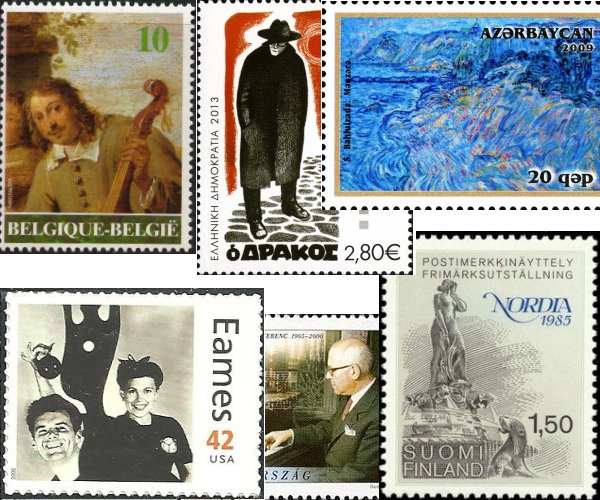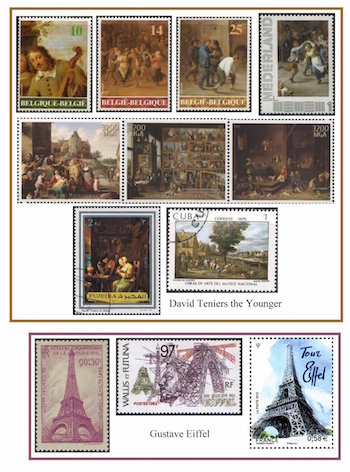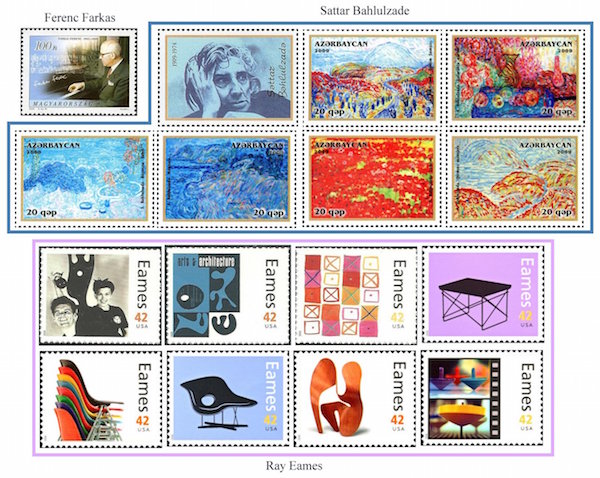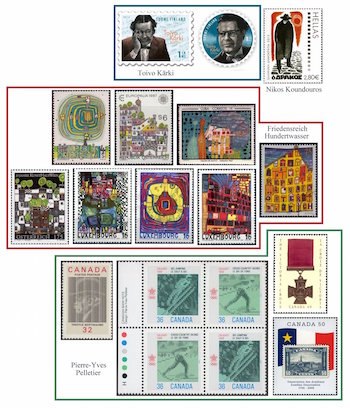The Arts on Stamps of the World — December 15
An Arts Fuse regular feature: the arts on stamps of the world.

By Doug Briscoe
Today’s most important artists are Flemish painter David Teniers the Younger and architects Gustave Eiffel and Oscar Niemeyer.

David Teniers the Younger (15 December 1610 – 25 April 1690) was the most prominent Flemish genre painter of his day. His father, a colleague of Peter Paul Rubens, painted altarpieces and cabinets, and three of David’s brothers also entered the profession. He married the daughter of Jan Brueghel the Elder with Rubens acting as a witness. Teniers became dean of the Antwerp Guild of Saint Luke around 1644 but about six years later moved to Brussels to serve the Archduke Leopold Wilhelm, Governor General of the Netherlands, as court painter. He also worked as curator of the Archduke’s picture collection. Through Teniers’s efforts, the Antwerp Academy was founded in 1663, only the second European institution of its kind after the one in Paris. The trio of stamps from Belgium begins with a detail of the artist’s Self Portrait with Family on Garden Terrace (1640s). The next few stamps show the merrymaking of villagers, with the one from the Netherlands presenting a detail from Peasant Kermis (festival). On the three stamps from Madagascar we see Works of Mercy, Archduke Leopold Wilhelm in his gallery in Brussels (1650-52), and The Kitchen (1646). I was unable to find dates or titles for the pieces shown on the stamps from Fujeira and Cuba. The musical duo on the Fujeiran stamp, though, puts me in mind of this whimsical concert.
French engineer and architect Gustave Eiffel (15 December 1832 – 27 December 1923) did a great deal more in his life than put up the Eiffel Tower. You may know that a few years earlier Auguste Bartholdi had requested his help in coming up with a practical supporting frame for the Statue of Liberty. The previous engineer had died, and Eiffel was chosen because of his knowledge of wind stresses. To begin at the beginning, Eiffel was born Gustave Bönickhausen in Dijon. The family had been using the name Eiffel for years, a reference to the Eifel mountains where they had originated. All throughout Eiffel’s youth and middle years Bönickhausen was the name he used, officially changing it only in 1880. He studied engineering and chemistry and went into business as a consultant in 1865. In the years to come he would design railway stations, bridges, viaducts, and more in locations all over the world: Chile, Peru, Bolivia, Estonia, the Grand Hotel Traian in Iași, Romania, a performing arts center in Maracaibo, Venezuela, bridges in Vietnam. He created the terminus for the Vienna-Budapest line in 1875 and the dome for Nice’s Astronomical Observatory in 1886. It was in the following year that work began on the foundations of the tower that bears Eiffel’s name, although the original design was actually by Maurice Koechlin and Emile Nouguier. In the same year, 1887, Eiffel became a contractor for an enterprise to build a canal across Panama. Unfortunately the program faltered, and Eiffel’s reputation was tarnished by association. He was even found guilty of misuse of funds, fined 20,000 francs, and sentenced to a two-year term, though this was later reversed on appeal. The whole business had a deterrent effect on Eiffel, who removed his name from his company, but he did not give up, proceeding with investigations into meteorology and aerodynamics as a means of gaining an even deeper understanding of wind forces.

An architect of perhaps even greater importance was Brazilian-born Oscar Niemeyer (December 15, 1907 – December 5, 2012 [sic]), whose birth name was Oscar Ribeiro de Almeida Niemeyer Soares Filho. He is most renowned for his collaborative work on the United Nations building in New York and for designing much of the cityscape for Brazil’s new capital of Brasília in 1960. Niemeyer studied in Rio de Janeiro and worked with his father in typography and as an architectural draftsman. In 1939 Niemeyer co-designed the Brazilian pavilion for the New York World’s Fair with Paul Lester Wiener and Lúcio Costa, who twenty years later would collaborate with Niemeyer again on the massive Brasília project. Niemeyer’s design for the United Nations headquarters was approved in 1947 but ended up a compromise with elements of design by Le Corbusier. Niemeyer’s Communist leanings prevented him from doing much work in the United States and even kept him from entering the country when he was appointed dean of the Harvard Graduate School of Design. He also went into exile in Paris from 1964 to 1985, a period of right-wing military rule in Brazil. For Brasília Lúcio Costa was responsible for the overall layout of the city, and Niemeyer designed the buildings, including the Brazilian National Congress and Cathedral of Brasília, as seen on various Brazilian postage stamps. (The man depicted on the stamp at bottom left is politician Ulysses Guimarães, who helped restore democracy in the country.) The story of the construction of Brasília is told in the French movie L’homme de Rio (The Man From Rio, 1964) with Jean-Paul Belmondo. In 1988, Niemeyer received the Pritzker Prize. Niemeyer’s wife Annita died after 76 years of marriage in 2004, and when Niemeyer was nearly 99, he married his secretary. In 2012 he lost his only child, a daughter, aged 82, and Niemeyer followed her in death six months later, days short of his 105th birthday.
The most renowned work of Finnish sculptor Carl Wilhelm “Ville” Vallgren (December 15, 1855 – October 13, 1940) is the Havis Amanda statue (1908) in Helsinki. Vallgren studied architecture there before attending the École des Beaux-Arts in Paris. He is otherwise known for his decorative arts: mirrors, figurines, lamp stands, urns, etc.
Better known for his furniture than for his architectural work is the Dane Kaare Klint (15 December 1888 – 28 March 1954), although one of his earliest efforts in the latter field was the completion of Grundtvig’s Church, left unfinished when his father Peder Vilhelm Jensen-Klint died in 1930. The younger Klint was apprenticed as a furniture maker and only later received instruction in architecture from his father. Klint’s very first furniture design was his 1914 Faaborg Chair, shown on the stamp. He also designed textiles and lamps, etc.
Hungarian composer Ferenc Farkas (FEH-rents FOR-kosh) was born 112 years ago today (15 December 1905). His teachers included Leó Weiner in Budapest and Ottorino Respighi in Rome. He followed in the footsteps of Bartók and Kodály (whose birthday is tomorrow) by collecting folk songs. After World War II (he was present at the siege of Budapest, working at that time with the Opera Chorus), he founded the Conservatory at Székesfehérvár (SAY-kesh-FAY-hair-var). From 1949 to 1975 he was composition professor at the Franz Liszt Academy, where his students included Kurtág, Ligeti, and Petrovics. I first became acquainted with Farkas through his delightful Ancient Hungarian Dances for wind quintet, but he wrote some 700 pieces of music, setting texts in thirteen languages. He died on 10 October 2000.

Azerbaijani landscape painter Sattar Bahlulzade (15 December [O.S. 2 December] 1909 – 14 October 1974) studied in Baku and Moscow. He sought inspiration mainly from the topography of his own country, once commenting, “I don’t need to go to Tahiti like Gauguin.” In 2009 his centenary was observed with a set of six stamps (the seventh item with his picture is merely a label) of his paintings: Ancient Shamakha, Saffron with Pomegranate, Buzovna Shore, Landscape (yes, the blue one), Poppies, and Red View.
In 2008 the United States released a sheet of sixteen stamps showing the industrial designs of husband and wife team Charles and Ray Eames. We showed half of them on Charles’s birthday back in June, and I’ve been holding on to the other half for Ray’s birthday today. She was born Bernice Kaiser in Sacramento 105 years ago today (December 15, 1912). In New York she studied abstract painting with Hans Hofmann and had her first show with other founding members of the American Abstract Artists group in 1937. She married Charles Eames in 1941 (her first, his second), and from then on they worked almost as a symbiotic unit in their diversified designs. One of these, a Christmas card for 1944, is a double portrait before one of their plywood structures. One of the pieces Ray designed on her own was the cover for the May 1943 issue of California Arts & Architecture magazine. She also created the pattern for the fabric design “Crosspatch” in 1945, jointly submitted with Charles to a 1947 MOMA competition. The other stamps from the set give us the Eames’s wire-based table (1950), stacking chairs (1955), La Chaise (1948), an abstract plywood sculpture (1940s), and a still from a 1969 short film they made called Tops. Charles Eames died in 1978, and Ray passed away died ten years later, to the day, on August 21, 1988.
Composer of more than 1400 songs, as well as music for about 50 films, numerous revues, plays, and radio productions, Toivo Kärki (3 December 1915 in Pirkkala – 30 April 1992 in Helsinki) was also an arranger of the music of other composers. He gave guidance to several Finnish lyricists and helped dozens of singers get their start in Finland’s music industry. I gather he also made a name for himself in Finnish tango.
Greek film director Nikos Koundouros (15 December 1926 – 22 February 2017) was born on the island of Crete. His first studies were in painting and sculpture at the Athens School of Fine Arts. He took sides with the leftists during World War II and was for a time incarcerated on the prison island of Makronisos, near Kea. He got his start in film as a cinematographer and directed his first movie in 1954. The stamp celebrates his 1956 feature O Drakos (Ο Δράκος, The Dragon, sometimes translated as The Ogre of Athens). At a film festival in Thessaloniki in 2006, critics voted it one of the ten best Greek films.

Born in Austria on December 15, 1928, Friedrich Stowasser decided in 1948 to call himself Friedensreich Regentag Dunkelbunt Hundertwasser (Realm-of-Joy Day-of-Rain Darkly-Multicolored Hundred-Waters). His mother was Jewish, but as his father had been Catholic they managed to pass as Christians during the Third Reich. Hundertwasser was even baptized in 1935 and joined the Hitler Youth. After the war, he studied briefly at the Academy of Fine Arts in Vienna and had an exhibition in that city in 1952-53. Around that same time he also began the study of architecture. Ultimately he worked in the main as a painter and graphic designer, responsible for many posters, coins, and—ah,ha!—postage stamps. We offer an array of these from Austria and Luxembourg, but he also designed stamps for the United Nations, Liechtenstein and Cape Verde, among others. The Cuban stamp shows his Night of the Drinker on a stamp for the 1967 art exhibit Salón de Mayo. Hundertwasser emigrated to New Zealand in the 1970s and was a staunch and proactive environmentalist. He died on the QE2 on February 19, 2000. For more on Hundertwasser, see the exhaustive Web site.
Another graphic designer is the Canadian Pierre-Yves Pelletier (born 1938 in Montréal). He was a student of design and typography in his native city and worked for a time for the CBC. Besides promotions, etc., he also produced more than twenty animated films for TV. In 1976 he served as Director of Publications for the Organizing Committee of the XXI Olympic Games in Montreal, and more recently he has been active in Web site design. Over the years he has produced well over a hundred stamps for Canada Post. The first of these was one in honor of newspaperman Trefflé Berthiaume. I chose also a set for the 1980 Calgary Winter Olympics, a 2004 stamp for the Victoria Cross, and one from 2005 recalling the expulsion of the Acadians, which began in 1755.
Two Englishmen separated by centuries and by vocation, if not by everything else, have this date in common. Author of The Compleat Angler Izaak Walton, born about 1594, died on December 15, 1683, and Dave Clark of the Dave Clark Five was born on 15 December in either 1939 or 1942.
A graduate of the University of Massachusetts with a B.A. in English, Doug Briscoe worked in Boston classical music radio, at WCRB, WGBH, and WBUR, for about 25 years, beginning in 1977. He has the curious distinction of having succeeded Robert J. Lurtsema twice, first as host of WGBH’s weekday morning classical music program in 1993, then as host of the weekend program when Robert J.’s health failed in 2000. Doug also wrote liner notes for several of the late Gunther Schuller’s GM Recordings releases as well as program notes for the Boston Classical Orchestra. For the past few years he’s been posting a Facebook “blog” of classical music on stamps of the world, which has now been expanded to encompass all the arts for The Arts Fuse.
